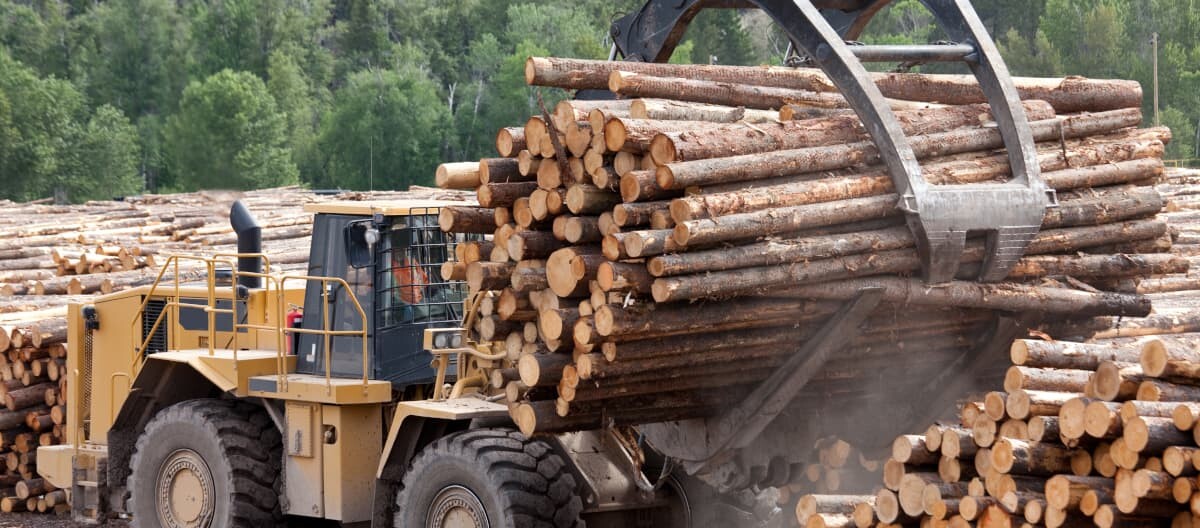Table of Content
- Sense of Crisis in the Timber Industry and the Pivotal Role of the Manufacturer of Construction Materials
- Timber Production Set to Fall Even Further - Dire Implications for the Manufacturer of Construction Materials
- Ecological Alternatives and the Crucial Innovation of the Manufacturer of Construction Materials
- Alternatives in the Building Trade: A Revolution Driven by the Manufacturer of Construction Materials
- Addressing the Firewood Crisis
- A Call for Adaptability, Innovation, and Collaboration
1. Sense of Crisis in the Timber Industry and the Pivotal Role of the Manufacturer of Construction Materials
The timber industry in Germany is not merely facing challenges; it is experiencing an unprecedented crisis. For months, the industry has been operating in a state of sustained emergency. The scarcity of raw materials, a fundamental component for any manufacturer of construction materials that relies on wood as a primary input, has led to ongoing production cuts across the board. These aren't minor adjustments; they represent a significant scaling back of operations, impacting the entire supply chain.
The Federal Association of the German Sawmill Industry has issued stark warnings, stating that short time working arrangements at wood processing companies are now a very real possibility, and in many cases, an unavoidable reality. This paints a stark picture of instability and uncertainty within the sector, directly impacting the livelihoods of thousands of workers and the ability of businesses to meet demand.
Sawmills throughout Germany, the crucial first step in processing raw timber, are facing unparalleled challenges in sourcing hardwood from regional forests. These forests, traditionally a reliable and sustainable source of timber for local processing and the backbone of the German timber industry, are no longer able to meet the demands of the industry. This disruption to established supply chains is causing ripples throughout the economy.
The manufacturer of construction materials is directly impacted, as their ability to source the necessary raw materials is severely compromised. Supply chains, the lifeblood of any manufacturing process, particularly for a manufacturer of construction materials, remain severely disrupted, further exacerbating the problem. This disruption isn't limited to a single point of failure; it's a systemic issue affecting the entire chain, from the forest floor where the trees are felled to the finished product delivered to the end consumer.
The consequences of disruptions in the supply chain are evident in the shifting prices of wood in 2024. While price surges of up to 80 percent were recorded in previous years, the current market reflects regional variations rather than uniform increases. Firewood, a necessity for many, particularly in rural areas where it remains a primary heating source, has seen significant price fluctuations.
In Lower Saxony, hardwood firewood is now priced between €40 and €50 per cubic meter, while softwood firewood costs between €30 and €35 per cubic meter. Additionally, in September 2024, the German producer price index for spruce log wood increased slightly by 0.1%, reaching 99.8 points. These price trends continue to affect consumers and businesses relying on wood as a fuel source, prompting some to seek alternatives or reduce consumption to manage rising costs.
Adding another layer of complexity to the situation is the continued export of timber, primarily to China, despite domestic supply concerns. This practice further strains the already limited availability of wood products. Between January and September 2024, Germany's oak log exports increased by 24% compared to the same period in the previous year, totaling 130,000 cubic meters. Notably, exports to China, the primary destination, surged by 86% to 84,000 cubic meters during this period. This significant outflow of timber resources has intensified supply pressures within the domestic market.
The situation with beech wood is even more concerning, highlighting the scale of the issue. In 2022, Germany harvested approximately 10.7 million cubic meters of beech wood. During the first half of 2024, around 200,000 cubic meters of sawn beech wood were exported, marking a 12% increase compared to the same period in the previous year. This export volume represents a small fraction of the total beech wood harvest, indicating that the majority of the harvested beech wood remained within the German market to help alleviate shortages and stabilize prices..
The lack of significant export restrictions for raw materials like wood within the EU framework allows this outflow to continue unabated, further depleting domestic resources and contributing to the deepening crisis. The manufacturer of construction materials is left to compete in a global market, even when domestic supplies are dwindling, creating an uneven playing field and putting immense pressure on German businesses.
As supply chain disruptions and rising costs challenge the timber industry, securing reliable construction materials is more critical than ever. Explore Europages’ product listings to stay competitive and keep your supply chain strong.
2. Timber Production Set to Fall Even Further - Dire Implications for the Manufacturer of Construction Materials
The future outlook offers little solace, with projections indicating a further, and potentially catastrophic, decline in timber production. The EU Commission's biodiversity strategy, while laudable in its environmental goals of preserving biodiversity and protecting ecosystems, has significant, and potentially detrimental, implications for forests and wood utilization.
A model-based study conducted by the Thünen Institute, a highly respected federal research institute under the German Ministry of Food, Agriculture and Consumer Protection, presents a chilling worst-case scenario that should send shockwaves through the industry. The study projects a potential 48 percent decline in log production by 2030. This dramatic reduction would necessitate significant, and potentially disruptive, adjustments across the entire timber industry and all related sectors.
The study suggests that approximately half of this substantial shortfall could be offset by a dramatic increase in imports from non-EU countries. However, this reliance on external sources carries its own set of inherent risks and challenges, including potential supply chain vulnerabilities, increased transportation costs, and potential quality control issues. It also raises concerns about the sustainability of timber harvesting practices in other countries.
Furthermore, the study highlights a critical and far-reaching consequence: a significant reduction in the production of sawn timber, wood-based materials, and pulp within the EU itself. This directly and severely affects the manufacturer of construction materials, limiting their access to essential raw materials and potentially forcing them to curtail production, raise prices, or seek alternative, and potentially less sustainable, materials. This could have a cascading effect on the entire construction industry.
Ironically, and perhaps most concerningly, the study points out that well-intentioned environmental actions, designed to protect the environment, can have unintended and significant negative consequences. The reduced availability of wood products, a naturally renewable resource with a relatively low carbon footprint when managed sustainably, could lead to their replacement by materials like concrete, steel, or aluminum in construction and other applications.
The production of these alternatives often has a significantly worse carbon footprint compared to wood-based options, releasing more greenhouse gases and contributing to climate change. Therefore, the intended benefit for biodiversity, achieved through reduced timber harvesting, could inadvertently cause environmental damage in other areas, creating a complex and challenging situation for policymakers and the manufacturer of construction materials.
This underscores the critical need for a holistic and balanced approach to environmental policy, carefully considering the interconnectedness of various industries and the potential for unintended consequences. A manufacturer of construction materials must diligently consider the origin of their products and all their suppliers, ensuring sustainable practices throughout the entire supply chain.

3. Ecological Alternatives and the Crucial Innovation of the Manufacturer of Construction Materials
The ongoing and worsening shortage of wood materials has forced a critical and urgent re-evaluation of material choices across various industries, from construction to furniture manufacturing. The manufacturer of construction materials is at the very forefront of this paradigm shift, actively seeking, researching, developing, and implementing sustainable alternatives to traditional timber.
Many end-users and companies are finding that wooden parquet, a traditionally popular and aesthetically pleasing flooring option, is either prohibitively expensive due to the dramatic price increases or simply unavailable due to depleted stocks. This scarcity has driven consumers to actively explore alternatives like linoleum floors. Linoleum, composed of linseed oil, wood or cork flour, and other natural components, offers a sustainable, durable, and aesthetically pleasing alternative to traditional wood flooring, representing a viable option for environmentally conscious consumers.
Cork, another natural and renewable material, is also rapidly gaining traction as a sustainable flooring option and a key material for innovative manufacturers of construction materials. The advantage of cork lies in its unique harvesting method. It is obtained from the bark of cork oak trees, a process that does not require felling the tree, making it a truly renewable and sustainable resource. The bark regenerates over time, allowing for repeated harvesting without harming the tree. This makes cork a particularly attractive option for the environmentally conscious manufacturer of construction materials looking for sustainable alternatives to traditional wood products.
Are you looking for a manufacturers of construction materials with a resilient and diversified supply chain? Request a quote on europages to find the ideal supplier.

4. Alternatives in the Building Trade: A Revolution Driven by the Manufacturer of Construction Materials
Within the building trade, the sector most heavily impacted by the timber shortage, the search for viable wood alternatives has led to a renewed interest in, and rapid development of, a range of innovative materials. Polymer-based materials are gaining prominence, offering several advantages over traditional wood. These materials are often easier to work with, providing greater flexibility in design and construction, and they are inherently resistant to moisture, a major cause of degradation in wood.
These properties make them particularly suitable for applications where wood might be susceptible to rot or damage, such as in damp environments or exterior cladding. The development and utilization of these materials represent a significant area of innovation and growth for the manufacturer of construction materials, allowing them to offer more durable and versatile building solutions.
Beyond polymers, other materials are emerging as promising contenders for the title of "building materials of the future," representing a significant diversification of the construction industry. These include:
- Timber Concrete: This innovative composite material cleverly combines the strength and durability of concrete with the insulating properties of wood, offering a potentially more sustainable and energy-efficient alternative to traditional concrete. The manufacturer of construction materials sees great potential in this hybrid material.
- Sand-Lime Brick: A traditional building material, but one experiencing a resurgence in popularity, sand-lime brick is made from sand, lime, and water. It offers good structural properties, is relatively environmentally friendly, and is readily available.
- Hemp Limestone: This increasingly popular and innovative material combines hemp fibers, a rapidly renewable resource, with lime, creating a lightweight and highly insulating building material with a remarkably low carbon footprint. The manufacturer of construction materials is exploring its potential for various applications.
- Utilizing Clay: Clay, a readily available, abundant, and natural material, is experiencing a significant resurgence in popularity as a building material, particularly for sustainable and eco-friendly construction. It offers excellent thermal mass, helping to regulate indoor temperatures, and can be used in various forms, including rammed earth, adobe bricks, and clay plasters.
These alternative building materials represent a significant and necessary shift away from the traditional, and now increasingly unsustainable, reliance on timber. The manufacturer of construction materials is playing a crucial, and indeed pivotal, role in researching, developing, testing, and promoting these alternatives, driving innovation and sustainability within the construction industry and ensuring a more secure supply of building materials.
5. Addressing the Firewood Crisis
The shortage of firewood, a direct consequence of the broader timber crisis, has also significantly impacted the heating sector, prompting a widespread search for alternative fuel sources. One promising and readily available option is tree bark briquettes. These briquettes are ingeniously produced as a waste product during the industrial processing of wood. By utilizing this otherwise discarded material, bark briquettes offer a sustainable, efficient, and cost-effective heating solution.
While the manufacturer of construction materials may not be directly involved in the creation of heating fuel, they are acutely aware of the availability and sustainability of all wood-related products and byproducts, understanding the interconnectedness of the entire timber ecosystem.
The bark is shredded, dried, and then compressed into dense briquettes. Due to their low moisture content, bark briquettes often have a higher energy output compared to even well-stored firewood, providing more heat per unit volume. This makes them an attractive and practical alternative for homeowners seeking a reliable and efficient source of heat, particularly in the face of rising firewood prices and limited availability. This approach not only addresses the firewood shortage but also promotes resource efficiency by utilizing a byproduct that would otherwise be wasted, contributing to a more circular economy.
Are you a manufacturer of construction materials looking for more exposure and reach? Request a consultation with our team to explore partnership opportunities.

6. A Call for Adaptability, Innovation, and Collaboration: The Path Forward
The wood shortage in Germany presents a complex and multifaceted challenge with far-reaching consequences for various industries and individuals. It demands a comprehensive and multifaceted response, encompassing policy adjustments, industry-wide innovation, and consumer adaptation.
A leading manufacturer of construction materials must be agile, adaptable, and at the forefront of innovation to navigate this challenging landscape successfully. The continued export of timber despite the acute domestic scarcity needs to be carefully and critically re-evaluated, potentially through the implementation of temporary export restrictions or incentives to prioritize domestic supply and stabilize the market.
The EU's biodiversity strategy, while undeniably important for long-term environmental sustainability, needs to be implemented in a carefully considered and phased manner that takes into account the potential economic and environmental impacts on the timber industry and all related sectors, avoiding unintended consequences.
The manufacturer of construction materials is playing, and will continue to play, an absolutely key role in navigating this crisis and shaping the future of the construction industry. The research, development, and widespread adoption of alternative materials, both in construction and other sectors, are crucial for mitigating the impact of the wood shortage and ensuring a sustainable future. This requires ongoing research, significant investment in new technologies, and a willingness to embrace innovative solutions and think outside the traditional timber-centric box.
Consumers also have a vital role to play, by actively considering and choosing alternative materials for their building and heating needs. Selecting sustainable options like linoleum, cork, or alternative building materials can help reduce the overall demand for timber and support the transition towards a more sustainable and resilient construction industry. A well-informed manufacturer of construction materials will actively educate the public about the benefits of these alternatives, promoting informed decision-making.
Ultimately, the wood shortage serves as a stark and timely reminder of the finite nature of natural resources and the paramount importance of sustainable practices in all industries. By embracing innovation, fostering collaboration between industry stakeholders, and adopting a long-term perspective, Germany can navigate this crisis and build a more resilient, sustainable, and resource-efficient future for its timber industry, the broader economy, and the environment.
The manufacturer of construction materials will be pivotal in the success of this transition, ensuring that the construction industry has access to the materials it needs while minimizing its environmental impact and promoting responsible resource management. The future will likely see a more diverse and balanced range of materials used in construction, with wood playing a significant, but perhaps less dominant, role than it has in the past. The manufacturer of construction materials will lead that transition, driving innovation and shaping a more sustainable future for the built environment.
This shift requires a fundamental rethinking of how we source, use, and manage our resources, ensuring that we meet the needs of the present without compromising the ability of future generations to meet their own needs. The manufacturer of construction materials will be at the very center of this rethinking, bearing the greatest responsibility and facing the most significant challenges in adapting to this new reality. The current German wood shortage is not just a temporary setback; it's a wake-up call and a catalyst for change, and the manufacturer of construction materials must be ready to answer that call.
For more information on construction and economics, read these insightful articles:
Wood's Comeback in Modern Architecture
Sustainable Style in Residential Design
the technical aspects of various wallpaper types
Beyond Paint: Transforming Houses with Wallpaper
The Modern Metal Construction and the future of construction
